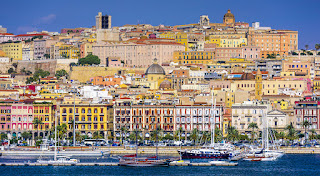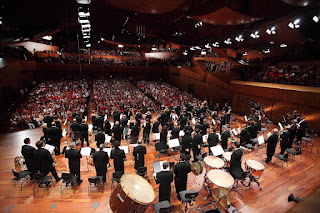Premature death robbed Italian music of great talent
The composer Ennio Porrino, best known for his symphonic poem, Sardegna, and his opera, I Shardana, was born on this day in 1910 in Cagliari.
Ennio Porrino is seen by some as
one of the greats of Italian opera
Porrino was critically acclaimed, his operas earning comparisons with the great Giacomo Puccini, although to some his reputation has been tarnished by his association with Benito Mussolini’s Fascist regime. He was only 49 when he died in Rome.
His 1941 opera, Gli Orazi, has been interpreted as a ‘hymn to fascism’ by some critics, while his piece, The March of the Volunteer, was used by Mussolini’s short-lived Italian Social Republic as its anthem.
Little is known of Porrino’s early years. It is thought that his family moved to Rome when he was a small child and most accounts of his life begin with his studies at the Accademia Nazionale di Santa Cecilia, which he attended from the age of 17 and where he graduated in 1932.
He also studied with the composer Ottorino Respighi, who was keen to see his potential realised. Respighi would be a significant influence on Porrino’s own work.
Porrino was not slow to make an impact in Roman musical circles. In 1931 he won an opera competition organised by the Giornale d'Italia newspaper. Two years later, his overture for orchestra, Tartarin de Tarascon, won the Accademia di Santa Cecilia’s own competition for the 25th anniversary concerts at the Teatro Augusteo, where it premiered under the baton of Bernardino Molinari.
 |
| Porrino studied under the violinist and composer Ottorino Respighi (above) |
Like Respighi, who died in 1936, Porrino championed an Italian national music movement faithful to its classical roots. He openly opposed modernist composers such as Alfredo Casella.
However, some academics argue that there was a dark side to Porrino’s enthusiasm for traditional Italian music, citing an article he wrote for an antisemitic journal, La difesa della razza - The Defence of Race - in 1938.
Under the title, La musica nella tradizione della nostra razza - Music in the tradition of our race - Porrino argued that Italian music was a fundamental component of Italian culture and national pride, but that it had been corrupted by internationalism, which was generally recognised as code for Judaism.
His opposition to Casella, it has been suggested, might have had as much to do with the latter’s opposition to Mussolini’s despised race laws as his music. Casella also happened to be married to a French woman from a Jewish family.
Porrino was also excited by Mussolini’s dream of restoring Rome to its former grandeur as the heart of his Fascist empire and his promotion of what he saw as the masculine, dynamic values of so-called romanità (Roman-ness).
 |
| Gli Orazi told the story of the feud between the Orazi and Curiazi families in 7th century Rome |
The one-act opera concludes with a victory for the Orazi in this feud and a celebration of Rome’s defeat of Alba in the war. Porrino collaborated with the librettist Claudio Guastalla on Gli Orazi, as he had in completing Respighi’s unfinished opera, Lucrezia, after Respighi’s death. Guastalla, though he regarded himself unequivocally as Italian, was the son of Jewish parents and his name ultimately disappeared from the credits.
Nonetheless, Gli Orazi was staged with great success at La Scala in Milan in February 1941.
After the fall of Mussolini and the defeat of the Fascists, the immediate post-war years saw Porrino devote more time to academic work than to composing. He was appointed professor of composition at the Rome Conservatory, and became a full member of both the Accademia di Santa Cecilia and the Luigi Cherubini Academy in Florence.
In 1946 he was appointed substitute librarian in the Library of the Conservatory of San Pietro a Majella in Naples, where he also taught composition. Later, he became director of the Pierluigi da Palestrina Conservatory of Cagliari, and conducted orchestral and choral performances in Naples and Venice.
 |
| Sardinia is dotted with the remains of nuraghe, conical stone towers as old as the Shardana |
Inspired by what Porrino had learned about his homeland after returning as an adult, the opera is regarded as one of the most important in Italy post 1945 and confirmed Porrino’s reputation, according to some critics, as the greatest Italian musician since Puccini.
It came as a profound shock, then, just a few months after I Shardana’s premiere at Teatro San Carlo in Naples, when it was reported in September 1959 that Porrino had died, following a sudden illness. He had been in Venice only a few days earlier, when his work La bambola malata, described as a pantomime, had been performed at the Venice International Festival of Contemporary Music.
He left a widow, Malgari, a painter and theatrical designer, and a daughter, Stefania, born in 1957, who became a playwright and stage director in adulthood.
Travel tip:An orchestral performance inside the modern
Accademia Nazionale di Santa Cecilia in Rome
The Accademia Nazionale di Santa Cecilia, one of the oldest musical institutions in the world, was established in 1565. It was founded in Rome by Pope Sixtus V at the Church of Santa Maria ad Martires, better known as the Pantheon. Over the centuries, many famous composers and musicians have been members, among them opera singers Beniamino Gigli and Cecilia Bartoli. Since 2005 the Academy’s headquarters have been at the Parco della Musica in Rome, which was designed by the architect Renzo Piano, in Viale Pietro de Coubertin in the Flaminio district, close to the location of the 1960 Summer Olympic Games.
Travel tip:
A view from the sea similar to that which the
writer D H Lawrence might have experienced
Cagliari, where Porrino was born, is Sardinia's capital, an industrial centre and one of the largest ports in the Mediterranean. Yet it is also a city of considerable beauty and history, most poetically described by the novelist DH Lawrence when he visited in the 1920s. As he approached from the sea, Lawrence set his eyes on the confusion of domes, palaces and ornamental facades which, he noted, seemed to be piled on top of one another. He compared it to Jerusalem, describing it as 'strange and rather wonderful, not a bit like Italy.’ What he saw was Cagliari’s charming historic centre, known as Castello, inside which the city’s university, cathedral and several museums and palaces - plus many bars and restaurants - are squeezed into a network of narrow alleys.
Also on this day:
1526: The birth of mathematician Rafael Bombelli
1920: The birth of film director Federico Fellini
1950: The birth of magazine editor Franca Sozzani
1987: The birth of motorcycle racer Marco Simoncelli

.jpg)
.jpg)
.jpg)


.jpg)
.jpg)




.jpg)
.jpg)
_02.jpg)